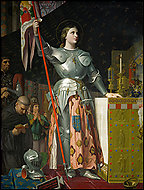Today is Joan of Arc’s saint’s day, so this week’s picture is Joan of Arc at the Coronation of Charles VII, by the French painter Jean-Auguste-Dominique Ingres. Painted in 1854, the picture is in the collections of the Louvre, in Paris.
Ingres elected to show France’s most cherished national heroine at the apogee of her extraordinary career, before her martyrdom at the hands of Englsih invaders. Born into the peasantry, her legend has it that when she reached the age of sixteen divine voices told her that it was her destiny to save her homeland. After a century of war, the English exerted a seemingly vice-like grip on Northern France, and Joan’s native city of Orleans would have opened the way to the south and further conquests. Early in 1429 she presented herself to the Dauphin, the future Charles VII, convinced him that he was the legitimate heir to the French throne and persuaded him that she was the divinely chosen instrument of victory. The Dauphin placed an army at her disposal, Joan of Arc ended the siege of Orleans and France triumphed. In July 1429, Charles VII was crowned king in the cathedral of Rheims while the Maid of Orleans looked on. This is the moment which Ingres chose to illustrate in his monumental, densely packed and airless fantasy of the medieval past – a painting which calls to mind the poet Baudelaire’s observation that when faced by a display of Ingres’ works he felt as if all the oxygen had been suddenly sucked out of the room.
The picture was a state commission and its subject was intended to cast reflected glory on Napoleon III, who had dissolved the French Assembly in 1851 and seized the reins of power in a bloody coup d’etat. Ingres’...


